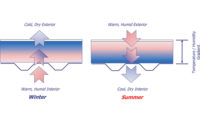As part of the RoofPoint rating program for sustainable roofing systems, the Center has developed a unique approach to the selection of energy-efficient roof surfaces. First, RoofPoint starts with the different energy-related outcomes a roofing designer may seek to achieve. In almost all cases, net energy savings will be important; and in many areas of the country the type of roof surface can make a big contribution in reducing total heating and cooling costs. In other areas, peak energy usage is also important, especially in localities with peak demand charges for the electricity needed to power air conditioning systems. Finally, reducing heat island effects may also be important, especially in dense urban areas.
In addition to recognizing different energy outcomes, RoofPoint also identifies a broad array of roof surface types to address these energy factors. In many parts of North America, especially in warm, sunny climates, highly reflective roofs may offer significant benefit in all three energy categories, saving both net and peak energy as well as reducing heat island effects. In cooler areas of North America, roofs with slightly less reflectivity may offer a workable trade-off between reducing solar heat gain in summer and minimizing solar heat loss in winter. And in climates with extremely cold winters and cool summers, low-reflective roofs may offer the best overall energy solution. In addition, RoofPoint also recognizes non-reflective surface options such as vegetative and ballasted roofs, which offer viable energy solutions in a wide variety of climates.
When you combine these energy goals with such a diversity of roof surface and climate options, the concept of “cool roofing” seems inadequate to cover all of them. As a result, RoofPoint uses roof surface thermal contribution to effectively address all of these possible outcomes and solutions. In addition, RoofPoint divides roof surface thermal contribution into sub-topics addressing net energy savings, peak energy reduction and heat island mitigation as separate and equal components of roof surface energy efficiency. These energy outcomes and roof surface choices are summarized in the requirements for RoofPoint Credit E3: Roof Surface Thermal Contribution (see Figure 1).
As compared to one-dimensional rating systems focused solely on highly reflective roofs, RoofPoint’s multi-factor approach offers several important benefits. First, by paying equal attention to net energy, peak energy and heat island issues, RoofPoint encourages better understanding of the relationship between desired energy outcomes and roof surface type. As a result, RoofPoint approach actually offers more potential credit and recognition in hot, sunny urban areas for highly reflective roofs that save both net and peak energy as well as reduce heat island effects. But at the same time, valuable options featuring lower reflectivity and other approaches are preserved for use in cooler climates.
By providing an expanded list of suitable roof surface options, RoofPoint also allows the roofing designer to consider additional roof surface factors such as maintenance requirements, durability and other roof-related functions. Finally, RoofPoint helps illustrate that roof reflectivity provides a continuum of benefit not necessarily limited by arbitrary cut-off levels.
In other words, RoofPoint effectively promotes cool roofs … plus!
To learn more about RoofPoint, please visit www.roofpoint.org.







